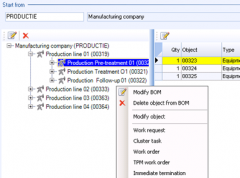Enterprise Asset Management System: maintenance functionality to effectively manage installations
Now more than ever, companies are looking for ways to work cost-effectively. They pay much attention to productivity, flexibility and quality. Rimses is the Computerized Maintenance Management System (CMMS) par excellence to effectively realize the company's objectives. Analysis of the functioning of the maintenance department reveals where problems and inefficiencies occur, how they are solved by the maintenance department and how operations can be improved.
The following functionalities are available for:
Smooth communication between production and maintenance
- Work requests
- Web requests
- Logbook
- Authorization of work requests and work orders
- Acceptance of work orders
Optimal functioning of the maintenance department
- Management of assets: installations, machines, devices, rolling stock, tools, spare parts (repairables),…
- Work order management
- Work preparation
- To-Do list
- Working hours registration (also by using scanner)
- Termination of work orders
- Work order history
- …
- Capacity planning
- Inspection rounds

Support of your maintenance strategy
- TPM (Total Productive Maintenance)
- CBM (Condition Based Monitoring)
- Breakdown maintenance
- Preventive maintenance
- Predictive maintenance
- Proactive maintenance
- Safety maintenance
Products
In eRimses you will find the functionality for creating work requests via the Internet.
All functionalities mentioned here are part of the products (with the exception of Capacity planning, LOTO procedures and Working papers):
The functionalities for Capacity planning, LOTO procedures and Working papers are not part of the product Rimses6 Fundamental.
Rimses Interface
If your company already uses an ERP system, you can use Rimses Interface to exchange data between your ERP system and Rimses, allowing you to perform all actions in just one system. The interface makes the required information available in the other system.
Rimses Interface also allows interfacing with other systems such as financial systems, production systems, ...
